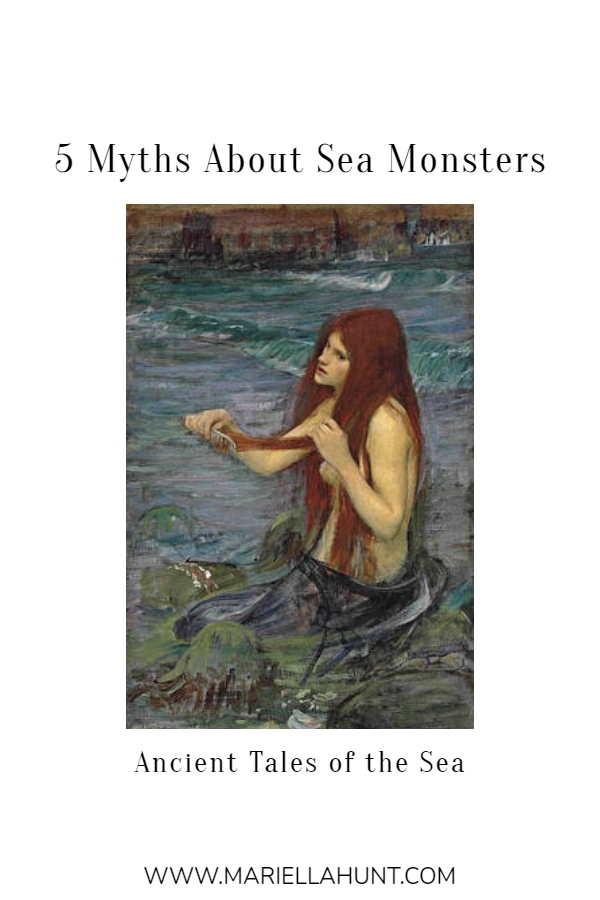Humans tell stories to shed light on the unexplained, giving it a face we can imagine. It’s been our custom for centuries, and one of the most frightening mysteries our ancestors faced was the ocean.
Whether they were fishing or embarking on voyages into the unknown, they had no guarantee of a safe return. The ocean was a moody mistress; they personified her by giving her faces.
Now we know more about the world under the sea, but there remain mysteries that will never be explained. Stories make things interesting; why not learn some ocean folklore to uphold the ocean’s personality?

Each-uisge
Not all sea monsters are giant squids of Jack Sparrow fame. The human imagination is adept at giving a shape to fear; something like water is impossible to keep in a set form.
Each-uisge is a sea monster of Scottish folklore. Its literal translation is water-horse. This monster is a shapeshifter; it can turn into a horse, pony, even into a handsome man!
Should somebody mount it while it is in horse form, they are only safe if the ocean is out of sight. A glimpse of the water changes the rider’s fate. The water-horse’s skin becomes like adhesive, making the rider helpless to dismount as the each-uisge dives into the sea.
Highland people are wary of wild horses—nobody wants to be drowned by a pony!

The Flying Dutchman
Ghost ships have marked ocean lore for as long as men have died at sea. Perhaps the most famous is the Flying Dutchman. Books and movies have been made about this spirit-ship doomed to sail on forever.
The oldest version of this legend originated in the 18th century. If hailed by another ship, the Flying Dutchman would attempt to send messages to land. At times, these messages would be to people long dead. Considered omens of death, sightings of the Flying Dutchman were dreaded by sailors.
Literary references to sightings of the Dutchman include a passage from Travels in various part of Europe, Asia and Africa during a series of thirty years and upward (1790) by John MacDonald:
The weather was so stormy that the sailors said they saw the Flying Dutchman. The common story is that this Dutchman came to the Cape in distress of weather and wanted to get into harbour but could not get a pilot to conduct her and was lost and that ever since in very bad weather her vision appears.
More literary references can be found on Wikipedia. A well-known sighting was reported by Prince George of Wales in 1880, the future King George V.
Charybdis
Scholars have placed this sea monster from Greek folklore in the Strait of Messina. Charybdis appears with the sea monster Scylla to challenge heroes such as Odysseus and Aenas. Later myths identify her as the daughter of Poseidon and Gaia.
Charybdis and Scylla lived under large rocks, one on each side of a narrow channel. There was no way to escape their trap; the term ‘to be between Charybdis and Scylla’ means being presented with two opposite dangers.
Charybdis created giant whirlpools three times a day. She did this by swallowing large amounts of water, pulling sailors to their doom. In some variations of the myth, she is simply a giant whirlpool.

Siren
Ocean mythology would be incomplete without mention of the Siren. Not to be mistaken with a Mermaid, Sirens exist in different cultures under different disguises.
Some cultures portray them as beautiful women who live in the ocean; others describe them as women with birds’ feathers and scaly feet. What all Sirens have in common is a wicked custom of luring sailors to their death, usually with their songs.
Ovid wrote that Sirens were the companions of Persephone as a young girl. After Persephone was kidnapped by Hades, Demeter gave them wings to find her. When they failed to locate Persephone, Demeter cursed them. They were destined to live only until the humans who heard their songs passed by.
Another legend says that Hera persuaded the Muses to participate in a singing competition with the Sirens. When the Muses won, they plucked the Sirens’ feathers as a punishment. Wingless, the Sirens fell into the sea of Aptera, where they formed the islands known as Leukai.

Funayūrei
Ships are not the only ghostly bodies thought to dwell near the ocean. According to Japanese legend, Funayūrei are angry spirits of the sea. They appear in writings from the Edo period; they have not faded from modern folk customs.
Funayūrei are said to be the spirits of humans who died in shipwrecks. These angry spirits want to doom more humans to death at the bottom of the ocean. They would make ladies fill boats with water in order to make them sink.
Their appearances vary widely in the different legends. Some float above the water; others appear on ships to haunt sailors. They are more likely to appear when it is raining or during nights when the moon is full.

Maybe you’ve never seen The Flying Dutchman, but have you heard the sound of wind before a storm? Have you ever stared at an approaching wave and wondered if it was coming for you?
The sea is full of mysteries. Since humans can never control the sea, it strikes fear into our hearts. Coming up with stories gives us a fleeting grasp on it.
I’ve gathered butterfly myths and star myths. The stories of our ancestors are a great part of who we are as a race. Get to know those beliefs; you might find that a voice deep inside of you still believes.





Leave a comment